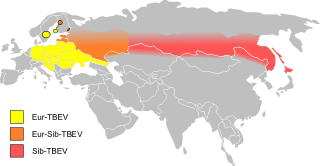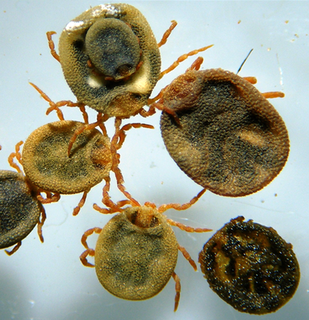Related Research Articles

Bartonella is a genus of Gram-negative bacteria. It is the only genus in the family Bartonellaceae. Facultative intracellular parasites, Bartonella species can infect healthy people, but are considered especially important as opportunistic pathogens. Bartonella species are transmitted by vectors such as ticks, fleas, sand flies, and mosquitoes. At least eight Bartonella species or subspecies are known to infect humans.

Tick-borne encephalitis (TBE) is a viral infectious disease involving the central nervous system. The disease most often manifests as meningitis, encephalitis or meningoencephalitis. Myelitis and spinal paralysis also occurs. In about one third of cases sequelae, predominantly cognitive dysfunction, persists for a year or more.

Thogotovirus is a genus of enveloped RNA viruses, one of seven genera in the virus family Orthomyxoviridae. Their single-stranded, negative-sense RNA genome has six or seven segments. Thogotoviruses are distinguished from most other orthomyxoviruses by being arboviruses – viruses that are transmitted by arthropods, in this case usually ticks. Thogotoviruses can replicate in both tick cells and vertebrate cells; one subtype has also been isolated from mosquitoes. A consequence of being transmitted by blood-sucking vectors is that the virus must spread systemically in the vertebrate host – unlike influenza viruses, which are transmitted by respiratory droplets and are usually confined to the respiratory system.

Nuttalliella namaqua is a tick found in southern Africa from Tanzania to Namibia and South Africa, which is placed in its own family, Nuttalliellidae. It can be distinguished from ixodid ticks and argasid ticks by a combination of characteristics including the position of the stigmata, lack of setae, strongly corrugated integument, and form of the fenestrated plates. It is the most basal lineage of ticks.

Borrelia is a genus of bacteria of the spirochete phylum. It causes Lyme disease, also called Lyme borreliosis, a zoonotic, vector-borne disease transmitted primarily by ticks and by lice, depending on the species of bacteria. The genus is named after French biologist Amédée Borrel (1867–1936), who first documented the distinction between a species of Borrelia, B. anserina, and the other known type of spirochete at the time, Treponema pallidum. This bacterium must be viewed using dark-field microscopy, which make the cells appear white against a dark background. Borrelia species are grown in Barbour-Stoenner-Kelly medium. Of 52 known species of Borrelia, 20 are members of the Lyme disease group, 29 belong to the relapsing fever group, and two are members of a genetically distinct third group typically found in reptiles. The Lyme disease group has been proposed to be split based on genetic diversity and moved to their own genus, Borelliella, but this change is not widely accepted. This bacterium uses hard and soft ticks and lice as vectors. Testing for the presence of the bacteria in a human includes two-tiered serological testing, including immunoassays and immunoblotting.

Babesia, also called Nuttallia, is an apicomplexan parasite that infects red blood cells and is transmitted by ticks. Originally discovered by the Romanian bacteriologist Victor Babeș, over 100 species of Babesia have since been identified.
Powassan virus (POWV) is a Flavivirus transmitted by ticks, found in North America and in the Russian Far East. It is named after the town of Powassan, Ontario, where it was identified in a young boy who eventually died from it. It can cause encephalitis, an infection of the brain. No approved vaccine or antiviral drug exists. Prevention of tick bites is the best precaution.

Coltivirus is a genus of viruses that infects vertebrates and invertebrates. It includes the causative agent of Colorado tick fever. Colorado tick fever virus can cause a fever, chills, headache, photophobia, myalgia, arthralgia, and lethargy. Children, in particular, may develop a hemorrhagic disease. Leukopenia with both lymphocytes and neutrophils is very common for Colorado tick fever virus. In either case, the infection can lead to encephalitis or meningitis.

Ixodes is a genus of hard-bodied ticks. It includes important disease vectors of animals and humans, and some species inject toxins that can cause paralysis. Some ticks in this genus may transmit the pathogenic bacterium Borrelia burgdorferi responsible for causing Lyme disease. Additional organisms that may be transmitted by Ixodes are parasites from the genus Babesia, which cause babesiosis, and bacteria from the related genus Anaplasma, which cause anaplasmosis.

Theileria is a genus of parasites that belongs to the phylum Apicomplexa, and is closely related to Plasmodium. Two Theileria species, T. annulata and T. parva, are important cattle parasites. T. annulata causes tropical theileriosis and T. parva causes East Coast fever. Theileria species are transmitted by ticks. The genomes of T. orientalis Shintoku, Theileria equi WA, Theileria annulata Ankara and Theileria parva Muguga have been sequenced and published.

Babesia microti is a parasitic blood-borne piroplasm transmitted by deer ticks. B. microti is responsible for the disease babesiosis, a malaria-like disease which also causes fever and hemolysis.
Ehrlichia chaffeensis is an obligate intracellular, Gram-negative species of Rickettsiales bacteria. It is a zoonotic pathogen transmitted to humans by the lone star tick. It is the causative agent of human monocytic ehrlichiosis.

Human granulocytic anaplasmosis (HGA) is a tick-borne, infectious disease caused by Anaplasma phagocytophilum, an obligate intracellular bacterium that is typically transmitted to humans by ticks of the Ixodes ricinus species complex, including Ixodes scapularis and Ixodes pacificus in North America. These ticks also transmit Lyme disease and other tick-borne diseases.

Adeleorina is a suborder of parasites in the phylum Apicomplexa.

Ornithodoros moubata, commonly known as the African hut tampan or the eyeless tampan, is a species of tick in the family Argasidae. It is an ectoparasite and vector of relapsing fever in humans, and African swine fever in pigs.
Achromatorida is an order of non-pigmented intraerythrocytic parasitic alveolates belonging to the subclass Haemosporidiasina. The order was created by Jacques Euzéby in 1988.

Hemolivia is a genus of the phylum Apicomplexia.

Ticks of domestic animals directly cause poor health and loss of production to their hosts. Ticks also transmit numerous kinds of viruses, bacteria, and protozoa between domestic animals. These microbes cause diseases which can be severely debilitating or fatal to domestic animals, and may also affect humans. Ticks are especially important to domestic animals in tropical and subtropical countries, where the warm climate enables many species to flourish. Also, the large populations of wild animals in warm countries provide a reservoir of ticks and infective microbes that spread to domestic animals. Farmers of livestock animals use many methods to control ticks, and related treatments are used to reduce infestation of companion animals.
Heartland bandavirus, sometimes called Heartland virus (HRTV), is a tick-borne phlebovirus of the Bhanja virus serocomplex discovered in 2009. The lone star tick transmits the virus to people when feeding on blood. As of 2017, only five Midwestern United States have reported 20 human infections, namely Arkansas, Indiana, Missouri, Oklahoma, and Tennessee; symptoms resemble those of two other tick-borne infections ehrlichiosis and anaplasmosis. The reservoir host is unknown, but deer, raccoon, coyotes, and moose in 13 different states have antibody titers against the virus.

Quaranjavirus is a genus of enveloped RNA viruses, one of seven genera in the virus family Orthomyxoviridae. The genome is single-stranded, negative-sense segmented RNA, generally with six segments. The genus contains two species: Johnston Atoll virus and Quaranfil virus; it has been proposed to contain species or strains including Cygnet River virus, Lake Chad virus, Tyulek virus and Wellfleet Bay virus. Quaranjaviruses predominantly infect arthropods and birds; As of March 2015, Quaranfil quaranjavirus is the only member of the genus to have been shown to infect humans. The Quaranfil and Johnston Atoll viruses are transmitted between vertebrates by ticks, resembling members of Thogotovirus, another genus of Orthomyxoviridae.
References
- ↑ Uilenberg, G. (1964). "Haematoxenus veliferus, n.g., n.sp., parasite incertae sedis du sang de bovins à Madagascar". Revue d'élevage et de médecine vétérinaire des pays tropicaux. 17 (4): 655–662. doi: 10.19182/remvt.7306 .